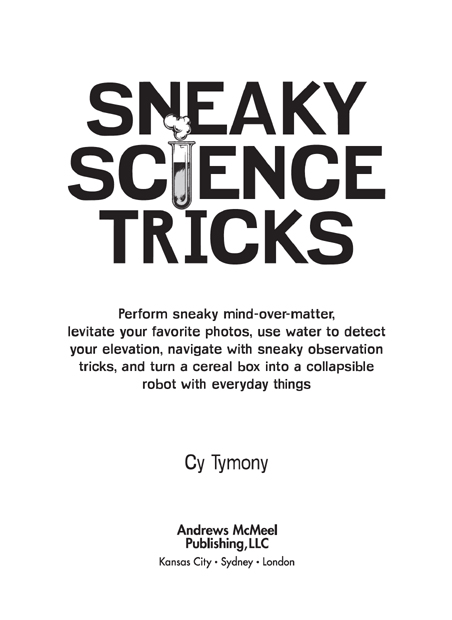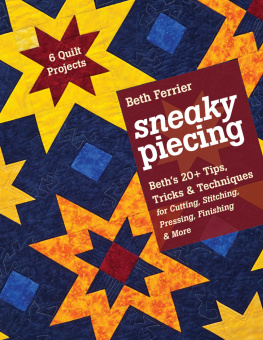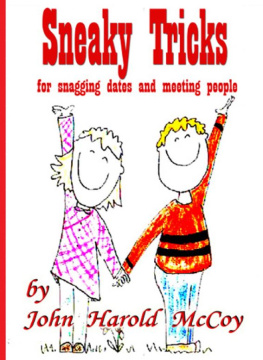

Sneaky Science Tricks copyright 2010 by Cy Tymony. All rights reserved. Printed in the United States of America. No part of this book may be used or reproduced in any manner whatsoever without written permission except in the case of reprints in the context of reviews. For information, write Andrews McMeel Publishing, LLC, an Andrews McMeel Universal company, 1130 Walnut, Kansas City, Missouri 64106.
E-ISBN: 978-1-4494-0016-3
Library of Congress Control Number: 2009943989
www.andrewsmcmeel.com
sneakyuses.com
Cover Illustrations by Gary Otteson

ATTENTION: SCHOOLS AND BUSINESSES
Andrews McMeel books are available at quantity discounts with bulk purchase for educational, business, or sales promotional use. For information, please write to: Special Sales Department, Andrews McMeel Publishing, LLC, 1130 Walnut, Kansas City, Missouri 64106.
DISCLAIMER
This book is for the entertainment and edification of its readers. While reasonable care has been exercised with respect to its accuracy, the publisher and the author assume no responsibility for errors or omissions in its content. Nor do we assume liability for any damages resulting from use of the information presented here.
This book contains references to electrical safety that must be observed. Do not use AC power for any projects listed. Do not place or store magnets near such magnetically sensitive media as videotapes, audiotapes, or computer disks. Disparities in materials and design methods and the application of the components may cause results to vary from those shown here. The publisher and the author disclaim any liability for injury that may result from the use, proper or improper, of the information contained in this book. We do not guarantee that the information contained herein is complete, safe, or accurate, nor should it be considered a substitute for your good judgment and common sense.
Nothing in this book should be construed or interpreted to infringe on the rights of other persons or to violate criminal statutes. We urge you to obey all laws and respect all rights, including property rights, of others.
CONTENTS
ACKNOWLEDGMENTS
Id like to thank my agents, Sheree Bykofsky and Janet Rosen, for believing in my Sneaky Uses book concept from the start. Special thanks to Katie Anderson, my Andrews McMeel editor, for her valuable support. Im also grateful to the following people who helped spread the word about the first five Sneaky Uses books: Ira Flatow, Gayle Anderson, Susan Casey, Mark Frauenfelder, Sandy Cohen, Katey Schwartz, Cherie Courtade, Mike Suan, John Schatzel, Melissa Gwynne, Steve Cochran, Christopher G. Selfridge, Timothy M. Blangger, Charles Bergquist, Phillip M. Torrone, Paul and Zan Dubin Scott, Dana Vinke, Cynthia Hansen, Charles Powell, Harmonie Tangonan, and Bruce Pasarow. Im thankful for project evaluation and testing assistance provided by Sybil Smith, Isaac English, and Bill Melzer. And a special thanks to Helen Cooper, Clyde Tymony, George and Zola Wright, Ronald Mitchell, and to my mother, Cloise Shaw, for providing positive motivation, resources, and support for an early foundation in science, and a love of reading.
INTRODUCTION
Sneaky Science Tricks will make your initial entry into science an extraordinary venture. It includes insight into the principles behind its projects, offering you even more sneaky knowledge.
For instance, after you make a Sneaky Boomerang, youll learn how it uses the Bernoulli principle to stay aloft. This scientific principle not only explains how birds and airplanes can fly but it also permits pitchers to throw sneaky sinking balls, improves automobile stability with rear spoiler, and lets sailboats sail directly into the wind. Youll fascinate your family and friends when you talk on a light beam, display gravity-defying toys, levitate objects, and do other projects that seem like magic.
Youll learn sneaky sources for wire and how to connect things. Youll see how to escape almost any grasp, make clever center-of-gravity balancing designs and sneaky boomerangs, and create a ring that controls devices.
Sneaky Trivia is also included so you can stump your family and friends with little-known geography, history, and nature facts. They will be astonished to learn which animal can shoot blood from its eyes; how fast bamboo grows in a day; how much the height of the Eiffel Tower varies in a day; which single state is the farthest north, south, or east; and how many drops of water can fit on a penny (over thirty!).
All of the projects have tested safe and can be made in no time. If you have an insatiable curiosity for sneaky secrets of everyday things, look no further. You can start your entry into clever resourcefulness here.
SNEAKY SCIENCE TRICKS
Are you stumped trying to come up with a different kind of science-project idea? Or do you want to repurpose some throw-aways into useful educational toys? This section presents over a dozen science tricks that will help you learn and demonstrate sneaky science principles easily. Virtually all of the items needed are already in your home, and the projects can be put together quickly.
Discover Bernoullis principle while you make flying boomerangs and Frisbee-like disks. Store energy in a rubber band and make a rolling can magically reverse direction and roll back to you, even uphill. Use a magnet to mysteriously activate lights, buzzers, or toys.
Ever think you could turn a black-and-white picture into color? Or talk on a light beam or break tough string without scissors? Well, you can. Youll see how to make a walk-along glider that floats in front of you and how to turn cereal boxes into a mobile robot.
All of these sneaky science techniques are right here ready for quick assembly. Lets get started!
BERNOULLI PRINCIPLE TRICKS
Sneaky Demonstrations of Air Pressure and Wing Lift
Have you ever wondered how airplanes and helicopters are able to fly? If you have, and want to demonstrate this principle, all you need are such ordinary items as straws, postcards, and strips of paper.
Air Pressure Demonstration I
An ordinary straw can be used to demonstrate that air pressure is all around us (15 pounds per square inch, to be exact). You can demonstrate this easily enough with everyday items.
Whats Needed
 Straw
Straw
 Glass filled with water
Glass filled with water

What to Do
Insert a straw into the glass of water, as shown in .












 Straw
Straw